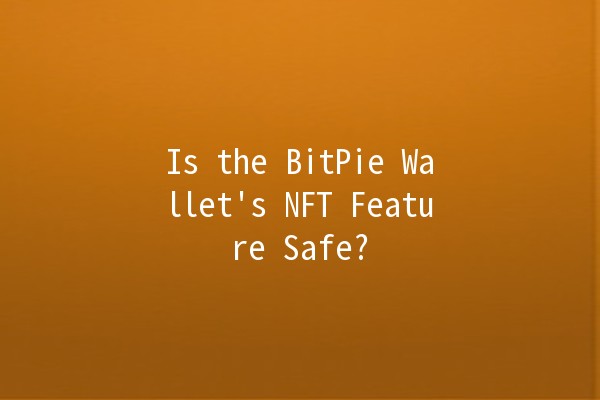
In recent years, NonFungible Tokens (NFTs) have surged in popularity, capturing the interest of artists, gamers, and investors alike. As the demand for securing and managing NFTs increases, wallet options like BitPie have emerged. But how safe is the BitPie wallet, specifically its NFT feature? In this article, we will delve into potential security risks, the wallet's functionalities, and provide practical tips for enhancing your NFT security within BitPie.
Understanding BitPie Wallet

What is BitPie Wallet?
BitPie is a decentralized cryptocurrency wallet that allows users to manage various cryptocurrencies and tokens, including NFTs. It’s designed to provide userfriendly access to digital assets while prioritizing security. BitPie supports multiple blockchain protocols, making it versatile for users interested in NFTs and DeFi applications.
Safety Features of BitPie Wallet
One of the key security measures of any crypto wallet is private key management. BitPie allows users to generate and control their private keys locally, minimizing the risk of thirdparty exposure.
Example: When you create a wallet with BitPie, it generates a unique private key stored securely on your device. It is crucial to back this key up because losing it can result in losing your NFTs permanently.
BitPie provides a multisignature feature, which adds another layer of security. This feature requires multiple keys to authorize transactions, making unauthorized access more challenging.
Example: If you have a multisignature wallet set up with BitPie, you could require approvals from both yourself and a trusted friend before executing any transaction involving your NFTs.
For mobile users, BitPie employs biometric security options like fingerprint and facial recognition. These features help prevent unauthorized access to your wallet.
Example: When you open the BitPie wallet on your smartphone, you may be prompted to use your fingerprint, ensuring that only you can access your digital assets.
Risks Associated with Using BitPie Wallet for NFTs
As with all digital platforms, users of BitPie may fall victim to phishing attacks. Scammers create fake websites or apps that mimic BitPie to steal user credentials and private keys.
Example: Always doublecheck the URL or QR codes before entering your credentials or scanning to prevent falling victim to phishing attempts.
The safety of your NFT assets within BitPie also hinges on the security of your device. If your smartphone or computer is compromised, your wallet could be at risk.
Example: Ensure that your device has robust antivirus software, and avoid downloading apps or files from untrusted sources.
Practical Tips to Enhance Your NFT Security within BitPie
TwoFactor Authentication is one of the simplest yet most effective ways to enhance security. It requires a second form of verification beyond your password.
Application: Use an authenticator app or SMSbased 2FA for your BitPie wallet. Whenever you log in, you will need to enter a verification code sent to your device.
Keeping your wallet application up to date ensures that you have the latest security patches and features. Developers regularly roll out updates to address vulnerabilities.
Application: Check for updates on your app store regularly, and enable automatic updates for a seamless experience.
For highvalue NFTs, consider using a hardware wallet in conjunction with BitPie. Hardware wallets store your private keys offline, providing an extra layer of security.
Application: Transfer your NFT to a hardware wallet like Ledger or Trezor for cold storage, and use BitPie for daily transactions or viewing your collection.
Always ensure you have a secure backup of your wallet. Write down your recovery phrase and store it in a safe place.
Application: When you first create your BitPie wallet, you will be provided with a recovery phrase. Make a hard copy and keep it secure.
Knowledge is power. Understanding the ecosystem of NFTs and digital wallets can significantly improve your security practices.
Application: Follow reputable sources, participate in forums, and stay updated on best practices and emerging security threats in the cryptocurrency space.
Using BitPie for managing your NFTs can be safe if proper precautions are taken. While the wallet offers robust security features, vulnerabilities still exist in the broader digital landscape. By adopting safe practices, users can protect their valuable NFTs effectively.
Frequently Asked Questions
Yes, BitPie Wallet incorporates multiple security features such as private key management, multisignature transactions, and biometric verification. However, users must also practice caution and employ additional security measures to enhance their protection against potential threats.
If you lose access to your BitPie wallet, you may still recover your NFTs as long as you have your private key or recovery phrase. This emphasizes the importance of securely backing up your recovery information.
If you suspect that you’ve fallen for a phishing scam, immediately change your passwords on BitPie and any linked accounts. If necessary, transfer your assets to a secure wallet and notify your contacts about the potential scam.
No, NFTs are not stored on the wallet itself but rather on the blockchain. BitPie acts as an interface allowing you to view and manage your NFTs stored on the blockchain.
Always download wallet applications from the official website or a trusted app store. Check reviews, developer information, and ensure the app has a significant user base. Look out for signs of a secure connection, such as HTTPS in the web address.
Yes, BitPie Wallet can be installed on multiple devices. However, ensure that you keep your backup phrases and private keys secure, as accessing your wallet on different devices may increase the risk of exposure.
, leveraging security features and adopting safe practices can ensure that your experience with BitPie and its NFT functionality remains secure. Understanding and mitigating risks can lead to a safer digital asset management experience.

